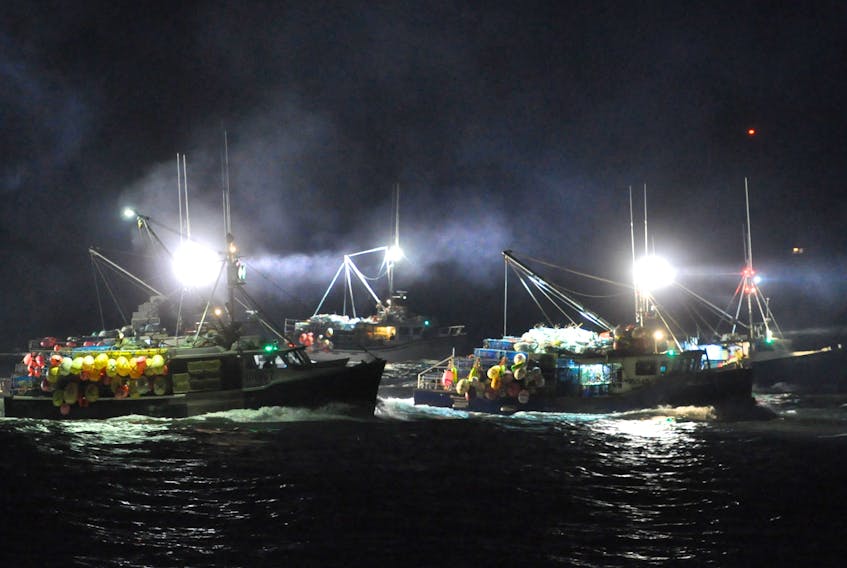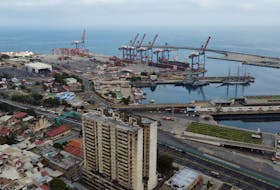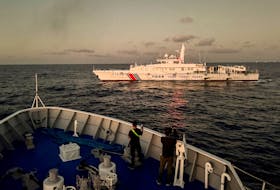The opening of the lobster fishery off southwestern Nova Scotia has been delayed due to the forecasted high winds.
The season, which was to have started on Monday, Nov. 27, with dumping day, will only start Tuesday at the earliest.
A decision to postpone the start of the LFA 34 (southwestern Nova Scotia) and LFA 33 (south shore of NS) seasons was made during Saturday morning conference calls to review the forecasted weather. Anything forecasted winds above 25 knots automatically cancels the start of the season.
Another conference call will be held Sunday morning to confirm if Tuesday will be a go or whether there will be a further delay.
All SAR assets in place for dumping day are slide back to whenever the opening day is.
PREVIOUS DUMPING DAYS
Sometimes the opening of lobster fishing off southwestern Nova Scotia goes off without a hitch. And sometimes not.
Here’s a look at some past season openings over the years.

2016: One-day delay: High winds on the last Monday of November postponed the start of last year’s season to the following day. Throughout the season fishermen saw high prices that continued to its end. During the week prior to the season wrapping up fishermen were still being paid $8 a pound for catches, but that’s because not as many lobsters had been landed during the season. Usually the end-of-season shore price is in the $4 to $5 range.
2015: Good start, good price: The lobster season got off to a good start with decent opening-day weather and, better yet, a better price than in previous years. Fishermen were being paid around $6 a pound for their landings.
2014: Six-day weather delay: After being delayed six days due to the weather, the lobster season in LFA 34, which takes in all of Yarmouth County and chunks of Shelburne and Digby counties, finally got underway the morning of Saturday, Nov. 29. The neighbouring LFA 33 district went with a Friday, Nov. 28 start. It was the second year in a row that strong winds delayed the opening. The season should have started Nov. 24.

2012: Should have stayed home: Days into the start of the lobster fishery many people were saying that fishermen should have heeded the warnings and uncertainty over price and waited to dump their traps at sea. Fishermen hauling in catches were only getting paid $3 a pound and there was a fear the price would drop more. At a Dec. 5 meeting on the Yarmouth wharf, a newsletter was informally distributed containing the heading “Uniting is the key.” But that was the problem, said fishermen. While everyone agreed they didn’t like the price, the fishermen were not united.
2008: Stay or go?: After a lot of debate, a lot of meetings and a lot of anxiety, it was decided to go with the Nov. 24 start of the lobster season in 2008. Given the early start because of where the last Monday of November fell on the calendar, some thought doing postponing the season start would generate a price advantage, while others just wanted to get on with fishing. The one area where the was strong agreement was no Sunday fishing for the duration of the season.
2009: Sundays – yes or no?: In the weeks leading up to the start of the lobster fishery, lobster licence holders voted on whether they wanted to give lobster landings a break for one day during each week of the upcoming commercial lobster season. The intention was not to flood the market with a glut of lobster. The year before there was no Sunday fishing the first three weekends of the season for much the same reason. But that hadn’t given fishermen the prices they were hoping for.
2000: Season opening, election day: Grey skies, drizzle and a forecast of an easterly gale set the stage for the season’s opening. The day got off to a quiet and safe start. Included in the season were 12 licences being fished by the Acadia First Nation, which had signed an interim fishing agreement with DFO that month, following six months of negotiations. Dumping day was also the day of the 2000 federal election. How many fishermen went to the polls to cast ballots was unknown, but it’s a pretty safe bet voter turnout within the industry was down, given that fishermen were busy with the start of the fishery.
1997: Illegal fishing concerns: Some discontent rocked the lobster industry in the preseason. Issues with illegal fishing had many of the fisherman worried that they wouldn’t be getting their fair share during the lobster season. Fishermen also wanted a clear indication regarding another fishery – the aboriginal fishers. They wanted to know whether aboriginal fishers had the right to fish year-round and whether they were allowed to sell what they caught. A Supreme Court decision – the Marshall decision – two years later spelled out the answers to a lot of these questions, particularly when it came to food, social and ceremonial purposes. Still, even in the year 2017, there are questions that remain by non-aboriginal fishers.
1995: Vessels sink, crews rescued: Very early on the sea claimed two vessels south of Yarmouth on the opening day of the season. The crew of the Simon Jacques out of Lower Wedgeport had to abandon their boat and were picked up by the nearby fishing vessel Lady Wallace. And four crewmembers were plucked from a liferaft and hoisted aboard a Labrador helicopter when their vessel, the Lady Candace fishing from Abbotts Harbour, had to abandon their boat after it started taking on water. The Rescue Coordination Centre said the crew was suffering from various stages of hypothermia.
1991: Price too low, we won’t go: In a matter of hours, a handful of fishermen organized a fleet tie-up that kept nearly 1,000 lobster vessels in port a week into the lobster fishery. And that number was expected to keep growing. Fishermen were protesting the low price they were being offered, which hovered around the $2.50 mark. Some fishermen even noted fishermen in Grand Manan were getting a better price. There they were being paid $3.50 a pound.
1991: Rallying to aid fishermen: The probability of taking part in the fall lobster fishery seemed slim for some Port Clyde lobster fishermen after a Nov. 21 fire destroyed their boat, lobster gear and the entire Cape Negro Wharf. But Shelburne County residents rallied for the fishermen with offers of fishing gear and a boat to use and the fishermen got to set their traps with everyone else when the season opened.
1986: “As good as last year”: The first week of the fishery was hampered by bad weather, but in Shelburne County fishermen claimed the harvest was “as good as last year’s.” The price settled at $3.25 and $3.50 per pound.
1972: Restaurants couldn’t afford to buy lobsters: A lobster boat made front page news on Nov. 22, 1972, when it caught fire. The headline read: “Fire destroys $15,000 lobster boat.” The 40-foot, fibreglass-built boat was brand new. The value was quite different compared to what boats are worth nowadays – with many new ones costing half a million dollars or more. As for the price of lobsters as the season got underway, a newspaper article stated: “The price opened at an all-time high of $1 per pound to the fishermen.” Later in the winter the price climbed to over $2 per pound. It was reported that these prices were so expensive that restaurants couldn’t afford to buy lobsters.
1970: Complaints about unfair advantage: Although the season got off to a good start weather-wise, two vessels fishing out of Wedgeport, Yarmouth County, were swamped with water. The vessels lost their traps but there was no loss of life. One of the boats was towed to Harry’s Island, where a bucket brigade of 20 fishermen helped to bail it out. Meanwhile, the federal fisheries minister had received complaints about auxiliary boats transporting traps to the fishing grounds. People complained that it was unfair since those who could afford to pay the hiring charges for larger boats could gain an advantage over the majority of the fishermen. Said Fisheries Minister Jack Davis: “Large boats, not registered as lobster vessels, are not allowed to engage in this practice.”
1966: Opening price 65 cents to $1: The year 1966 saw beautiful opening-day weather, with temperatures soaring above normal and calm seas. The opening price was to be anywhere between 65 cents a pound and a dollar a pound. The opening price the previous year was said to have been a “record-breaking” 90 cents a pound. The record-breaking high before that had been 65 cents a pound. You couldn’t be on a lobster boat without a fishing licence. Not to worry, however, you could purchase one for just 25 cents!









